|
Traditional Chinese medicine (TCM) treatment for itchy skin conditions usually combines oral and external remedies. The external remedies are essential, which not only can stop itching, but also help peel dead skin, arrest oozing, lighten darkened skin, soften hardened and thickened skin, and even have anti-septic and anti-fungal effects. Individuals can attain a faster and more direct result than with oral drugs and can avoid adverse drug stimulations on the intestines as well.
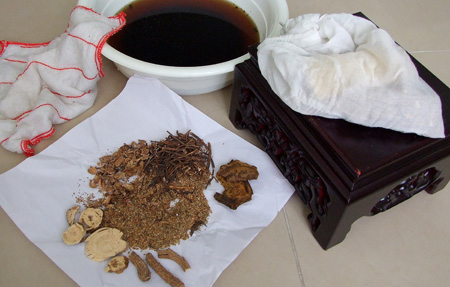
Chinese herbal washing or dressing for skin itching.
|
According to TCM experiences, pathogens that caused itching are mainly on the exterior part of body. When using herbs to stimulate the affected skin, that opens the skin pores and striae, and activates blood and qi (vital energy), it can facilitate the pathogens to expel through the body surface, and achieve a therapeutic result. For mild itchy cases, external herbal remedies alone are well enough for relief too.
Here are some external therapies for generalized itching:
Herbal washings and wet dressings to stop itchy skin
Washing and wet dressing are the most common external therapies for skin problems. Physicians use a wide range of herbs for washing and wet dressing, depending on the disharmony patterns of patients and involved body parts. The ingredients are selected to relieve itchiness, reduce swelling, anti-inflammatory, calm down the body and promote the healing process.
 |
Ledebouriella root (20g), angelica root (15g), astragalus root (20g), amur corktree bark (10g), Chinese safflower (10g), Sichuan lovage rhizome (10g), sulfur (10g), and sopora root (10g). |
 |
Argy wormwood leaf (90g), realgar (6g), pricklyash peel (6g), and ledebouriella root (30g). |
 |
Chinese rhubarb, common cnidium fruit, chaulmoogra tree seed, sopora root, angelica root, and cistanche for 15g each; amur corktree bark, atractylodes rhizome and Sichuan lovage rhizome for 12g each; baical skullcap root (9g); figwort root (30g) and borneol (3g, add in the decocted solution). |
 |
Unprocessed fleeceflower root, argy wormwood leaf, belvedere fruit, duckweed, Dahurian angelica root, baical skullcap root, notopterygium root, pubescent angelica root, ledebouriella root, schizonepeta herb, sodium sulfate and liquorice root 10g for each; and peppermint (5g). |
 |
Sopora root (15g), Chinese rhubarb (15g), ledebouriella root, Sichuan lovage rhizome, pricklyash peel, dried ginger and akebia stem for 10g each; and Manchurian wildginger (6g). |
 |
Sopora root (15g), amur corktree bark, pricklyash peel, and cicada slough for 10g each; belvedere fruit, common cnidium fruit, Siberian cocklibur fruit and dictamnus root bark for 12g each; and processed alum (9g). |
 |
Belvedere fruit (12g) and wild chrysanthemum (12g). This is for itchiness in pregnant women. |
 |
Alum (10g), salt (10g) and fresh peppermint (1.5kg). |
 |
Indian madder root (100g), rehmannia root (100g), peony root bark (100g), arnebia root (60g), red peony root (100g), wolfberry root-bark (100g), dictamnus root bark (100g), pagoda tree flower (50g), common cnidium fruit (50g), belvedere fruit (50g) and caltrop fruit (50g). This is suitable for itchy skin condition with heat signs. |
 |
Notopterygium root (100g), cassia twig (100g), ledebouriella root (100g), Siberian cocklibur fruit (50g), sopora root (100g), astragalus root (50g), cassia bark (50g), dried ginger (50g), dictamnus root bark (50g), common cnidium fruit (50g), and belvedere fruit (50g). This is suitable for itchy skin condition with cold signs. |
 |
Dictamnus root bark (30g), amur corktree bark (20g), atractylodes rhizome (20g), weeping forsythia capsule (20g), Chinese rhubarb root (10g), baical skullcap root (10g). Additional herbs are selected according to the primary affected regions, for example, head region add chrysanthemum (10g); facial area add Dahurian angelica root (15g); upper limbs add cassia twig (10g); rib sides add bupleurum root (15g); groin area add Chinese gentian root (15g); with excess oozing add garden burnet root (15g); and with secondary infection add golden thread rhizome (15g). |
For washing application, boil the ingredients with 2000ml of water for 15 minutes, then mix the solution with warm water in the tub, soak for no longer than 30 minutes, meanwhile use a towel to gently pat on the body surface.
For wet dressing application, decoct the ingredients to make a concentrated solution, dip a thick piece of gauze with the cool solution, cover it on the itchy area, change the gauze every 10 minutes, do this repeatedly, or until the prickly and itchy sensations alleviated.
Applying twice a day is usually suggested. One pack of herbs can be used for three days, and three packs are as one course of treatment. After the bath, rinse the body and apply cream or lotion for moisturizing. Remember to rest for half an hour and drink water to replenish lost body fluid. It should be noted that when there are open wounds, washing and dressing methods are not indicated.
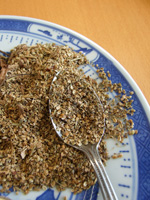 |
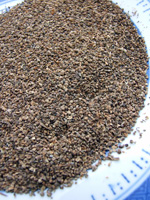 |
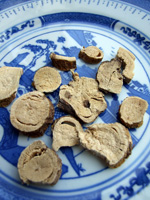 |
| Common cnidium fruit |
Belvedere fruit |
Sopora root |
Herbal lotions, creams or tinctures to stop itchy skin
Preparations like lotion, cream and tincture can enhance the lubricating effects of anti-itch treatment, to soothe the cracked, dry and rough skin. They are beneficial to stubborn itchy conditions. The form of application is carefully considered, and some special ingredients may be added in the remedies to facilitate drug absorption or solubility. For example, alcohol or vinegar can enhance the body surface to absorb the active ingredients from the herbs, TCM physicians usually add in the anti-itch remedies.
 |
Camphor, sessile stemona root and liquorice root for 10g each; crush the herbs into coarse powder, mix with 200ml of 60% alcohol, store in a container, seal and soak under room temperature for 7 days. Filter the solution into another container, put in the camphor and stir to make it dissolve completely, add in 200ml of 50% glycerine and mix properly. Applying on the body 4 times daily. This is beneficial to skin itchiness in elderly people. |
 |
Sopora root (30g), processed alum (20g), golden thread rhizome (10g), amur corktree bark (20g), realgar (10g) and borneol (3g). Grind into fine powder, and mix with vaseline to make a cream. |
 |
Golden larch bark, common cnidium fruit, and sessile stemona root for 30g each; gallnet of Chinese sumac (24g), processed lead powder (18g) and mercurous chloride powder (6g). Grind into fine powder and mix with rice vinegar to make as paste form. |
 |
Peppermint (30g), sopora root (30g), and camphor powder (15g); soak the two herbs in 600ml of 60% alcohol for 7 days. Then filter out 500ml solution and store in a bottle, add in the camphor powder and stir evenly. Every time, when itchiness appears, use a cotton tip or brush to dip up the solution and apply on the affected area, do this several times a day. The solution is effective for hive, especially for the early stage of hive in children. |
 |
Sopora root (30g), peppermint (30g), common cnidium fruit (30g), belvedere fruit (30g), dictamnus root bark (30g), fragrant Solomonseal rhizome (50g), liquorice root (50g), ledebouriella root (30g) and angelica root (50g). Grind the ingredients into coarse powder, soak in 1600ml of 60% alcohol for 7 day under room temperature. Then filter out the solution and store in small bottles for 100 ml each, add in 3g of camphor powder in each bottle. Every time before applying, shake well and use a cotton tip or a brush to dip up the solution and apply on the affected area, do this three times a day. This can lubricate the skin, dispel the accumulated wind pathogen and stop itchiness. The solution is suitable for winter itchiness. |
 |
Siberian solomonseal rhizome (15g), angelica root (15g), figwort root (15g), sopora root (15g), dictamnus root bark (15g), caltrop fruit (15g). Grind the ingredients into coarse powder, soak in 200ml of 60% alcohol for 7 day under room temperature, filter out the solution, add in 200ml of 50% glycerine, mix and store in a container. Apply on the affected body region 3 times a day. This can lubricate the skin, reduce irritations and stop itchiness. |
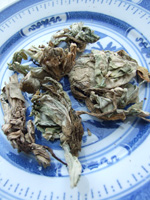 |
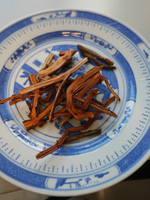 |
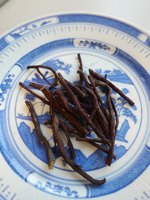 |
| Duckweed |
Indian madder root |
Arnebia root |
Herbal powder to stop itchy skin
Herbal powders are beneficial for skin conditions with excess moisture or for drying purpose in addition to arrest itching.
 |
Dried aromatic ginger (30g), Dahurian angelica root (30g), smithsonite (calcined, 30g), and borneol (30g). Grind into fine powder and store in a container. Dust the affected area with the powder when itchiness appears. This is suitable for hives in summer. |
 |
Duckweed (30g), common cnidium fruit (30g), belvedere fruit (30g) and caltrop fruit (30g). Grind into fine powder and store in a container. When applying, use a piece of gauze to wrap some powder, wet with vinegar, and then gently pat the itchy area. Whenever itchiness appears, do this until it feels alleviated. This is suitable for skin itchiness or neurodermatitis. |
 |
Calcined smithsonite (30g), talc (25g), dictamnus root bark (25g), and belvedere fruit (25g). Grind into fine powder and store in a container. Dust the affected area three times a day. This powder is suitable for hives and contact dermatitis. |
 |
Duckweed (50g), peppermint (50g), common cnidium fruit (50g), belvedere fruit (50g), and borneol (20g). Grind into fine powder and store in a container. Dust the affected area if necessary. This powder is suitable for generalized itchiness in the elderly or diabetic patients. |
 |
Common cnidium fruit, clove and Dahurian angelica root for 20g each; Manchurian wildginger, atractylodes rhizome, Chinese mugwort leaf, nutgrass flatsedge rhizome, and realgar for 10g each; and borneol (5g). Grind all the herbs into fine powder mixture, store in a container and put aside. Dust on the affected area whenever an itching appears, or at least 3 times a day. |
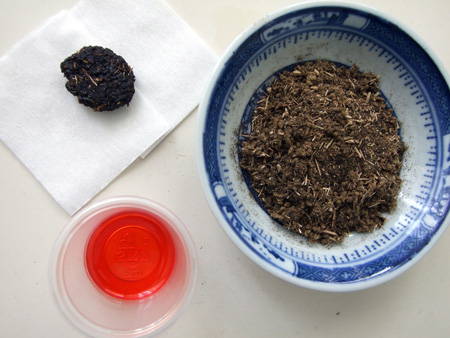
Herbal powder, paste and tincture
|
|